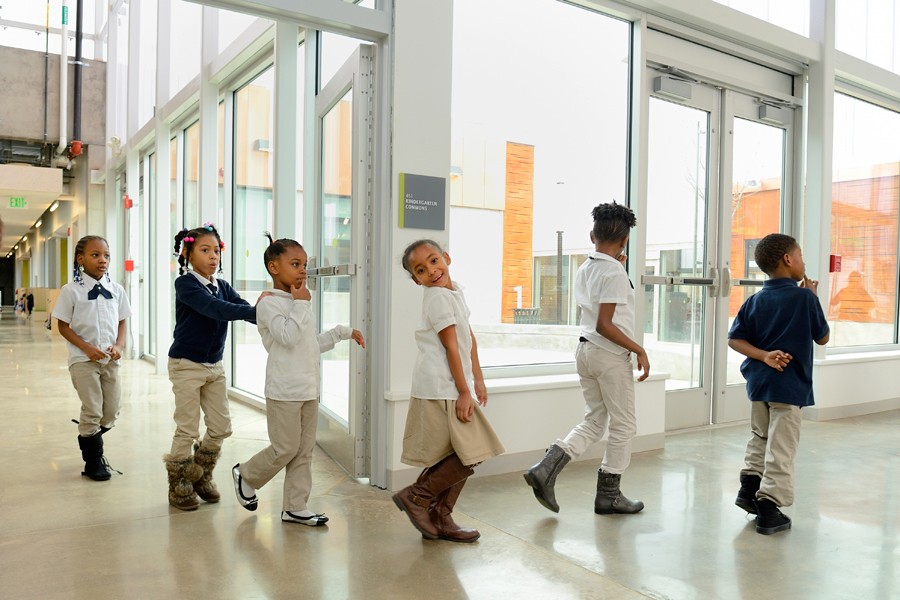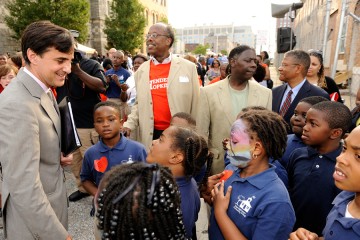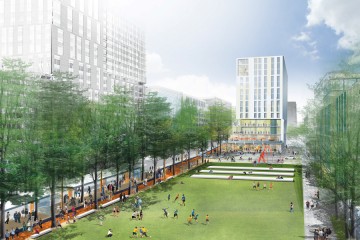Editor's note: This article will be published in the forthcoming January/February issue of the Gazette.
During the June 2012 groundbreaking ceremony for the Henderson-Hopkins K-8 elementary/middle school, Johns Hopkins President Ron Daniels noticed an Amtrak train whizzing by. "Imagine that in the years to come," he told the crowd, "when people go up and down the Northeast corridor, what they will see in East Baltimore is this magnificent school."
Just a year and a half later, when southbound train passengers approach Baltimore's Penn Station, that's exactly what they see.
Last week, teachers welcomed the first students to Henderson-Hopkins, a $43 million facility that's seen as a key component of the 88-acre biotech and residential urban renewal project started in 2003 by East Baltimore Development Inc., a nonprofit organization formed by the city and state and whose core investors include Johns Hopkins University and the Annie E. Casey Foundation.
The modern-looking edifice sprawls over eight acres, a brick-colored, highly designed anomaly in a section of town where boarded-up row homes remain a common sight.
Operating under a contract with Baltimore City Public Schools, Henderson-Hopkins is operated by the Johns Hopkins University School of Education in partnership with Morgan State University's School of Education and Urban Studies.
This is the first new school to have been built in East Baltimore in more than 20 years, and it marks Johns Hopkins' first foray into university-assisted community school partnerships, a strategy of education reform that has been spreading throughout the United States during the past 30 years. Henderson-Hopkins—whose formal name is Elmer A. Henderson: A Johns Hopkins Partnership School—will serve as a demonstration school of sorts, allowing School of Education students to work there closely with teachers and children, bringing back to university classrooms what they've learned in the field.
"This school will change the way we think about training teachers for the future," says David Andrews, dean of the Johns Hopkins School of Education. "What we learn there will come back into our higher education programs that change the way we train teachers to work in these types of educational settings."
University officials and community organizers also hope the school changes the very fabric of the economically depressed neighborhood as well, helping to attract a mixed income population and, as Daniels said in his September 2010 inaugural address, "restoring the city's east side as a safe, prosperous, and vibrant community."
To that end, Henderson-Hopkins uses a holistic approach to education, involving not just the students but their families and the community at large. The new building boasts a family resource center to be used for lectures and meetings, parenting presentations, and job training. Students and faculty from Johns Hopkins' School of Nursing and staff from the Baltimore City Health Department oversee the health suite and work with families on issues pertaining to health and nutrition. Both the resource center and health suite will facilitate a higher level of partnership between the school and its families—fundamental to creating a positive learning experience for students, says Katrina Foster, the school's first principal. "My attendance rate is the most important measurement of success to me," she says. "We can't do anything without them here."
It's quickly apparent to any visitor of Henderson-Hopkins that this is not your ordinary school. The building is divided into five "houses," including the $10 million, 30,000-square-foot Harry & Jeanette Weinberg Early Childhood Learning Center, for kids as young as 6 weeks. Each house has its own central meeting area and adjacent "servery," or cafeteria, modular spaces that can be rearranged as teachers see fit. The communal rooms, with their soaring, wood-lattice ceilings, ceiling fans, and large windows, look more like high-end office building lobbies than something you'd find in a public school.
High-tech gizmos, from "smart" white boards to large-screen TVs and laptop computers, abound, as do reading areas and flexible work spaces where teachers can divide kids into smaller groups across grade levels. Teachers don't have their own desks in this new education paradigm; instead, they use teacher suites to help foster collaboration and collegiality.
There's a full-size gymnasium, an airy art room, music rooms with practice suites, and a 350-seat auditorium, available for community use. Eighth-graders get their own rooftop deck, an exclusive perk for the senior members of the school.
As the new semester progresses, Foster can't wait to see how her staff utilizes the building. "The aesthetics are beautiful," she says. "There's a ton of natural light, and nooks and crannies to use as creative learning spaces. Right now, we'll have to work to turn the building into a school, just like you turn a house into a home. It'll take us a while to figure out how we can make it all work."
Teachers are using a curriculum based on Success for All, a literacy and language program developed by Johns Hopkins School of Education Professors Robert Slavin and Nancy Madden that emphasizes cooperative learning, steady assessment, and family engagement. It's used in approximately 1,500 schools nationwide.
"It's really a 21st-century learning model," says Foster. "I think the space really allows us to facilitate all those objectives in a really cool way. We're not bound by rooms or lack of access to technology. It's really going to help bring our students into the 21st century."
"Personalized" education is another buzzword here, with teachers keeping easily accessible computerized records on student achievements, test scores, strengths, and weaknesses. "We've been teaching to the middle for a long time—the one-to-many approach," says Andrews. "In the personalized approach, teachers use accumulative information for each student so they're better able to prescribe the right type of learning for them, whether it's in small groups, one-on-one, tutoring online, or even larger groups. We'll have the technology to have all of that data available in one place. It's the same kind of thing we're doing in personalized medicine."
Andrews, who purchased a home in the neighborhood two years ago, says that he's eager to see the impact Henderson-Hopkins has on the community and that he hopes the school will serve as a national example for personalized education. "We want it to be a model for how we're able to attend to the needs of every student and maximize their performance," he says. "I'll know we've been successful 10 years from now if other schools are adopting practices that have been developed and tested at Henderson-Hopkins."
For Foster, who attended Baltimore City public schools growing up, Henderson-Hopkins' success is personal. In two years her son, T.J., will enter kindergarten at the school and, like any parent, she says she won't settle for anything less than the best education for her son. "I tell people all the time, This has to be the best place because he's coming! And that's how we have to feel about every child who walks in the door. I want every parent to feel like this is a school that's going to love their child, nurture their child, and help their child reach their potential, which is exactly what I want the school to do for my son."
Posted in University News, Politics+Society, Community
Tagged east baltimore, education, community, henderson-hopkins











